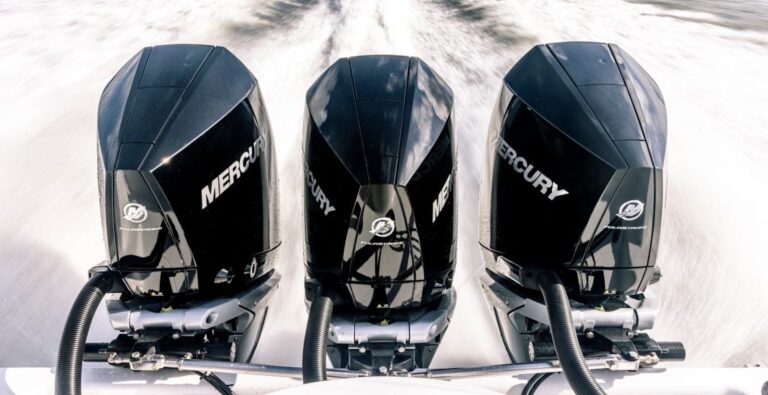Kara Diehl was in the hospital with complications from Type 1 diabetes when her phone rang. The caller was inquiring about her late father’s abandoned boat. “I didn’t know my dad had owned a boat,” says Diehl, who lives in Virginia Beach, Va. “I knew that he was living on one, but I didn’t know he had purchased it.”
The caller, Mike Provost, was the founder of Vessel Disposal and Reuse Foundation, a nonprofit organization also based in Virginia Beach that removes derelict boats. He told Diehl her father had abandoned the vessel. It was in a prominent location in front of the Dockside restaurant, a popular waterfront hotspot near the Lesner Bridge in Virginia Beach.

“Mike reached out to me as next of kin to remove it from its location at no charge to our family,” says Diehl, who was estranged from her father. “I had all these mixed feelings about my father passing, so I was very relieved when Mike reached out because it felt like a cleansing thing.”
VDRF removed the sunken Holiday Mansion houseboat April 29, 2022. Salvaging the derelict boat was more than a cleanse for Diehl’s psyche. Derelict and abandoned boats are environmental and navigational hazards on waterways nationwide. Anyone who spends time on the water has seen these hulks at anchor or semisubmerged and rolled over on their side. Those that sink can spread pollutants that wreak havoc on the environment and the people who recreate on or near those waters.
In Florida, in the aftermath of Hurricane Ian, it was estimated that there were 6,000 derelict boats in southwest part of the state. In most cases, boat owners don’t know resources are available to remove them because until recently there weren’t many.
“I thought that my dad had an arrangement with someone,” Diehl says. “As long as I’ve known the man, he never owned a boat, a car or a house.”

Diehl is a divorced mother of two teenagers and could not afford the cost to remove the boat her father abandoned because he was tired of living with the rats that had taken over the vessel. “I felt responsible for it in a moral sense,” she says.
Taking Matters Into His Own Hands
Provost retired from U.S. Navy special operations and now works as a regional sales rep for electric-boat manufacturer X Shore. “I’m an environmentalist,” he says. “I have 15 solar panels on top of my house, and I drive an electric car.”
He started VDRF out of necessity and frustration. He frequented First Landing State Park in Virginia Beach with his kids. In 2021, he was disgusted by the sight of an abandoned 35-foot cruiser that was grounded at the popular recreational area. “I said, ‘I’ll do the right thing and report it,’ ” he recalls. Provost estimates that he talked to about a hundred people at 30 organizations, all of whom had the same response: We don’t have the funding or the authority to do anything about it.

He and a friend organized a GoFundMe campaign to raise the $11,000 it would cost to remove the boat. Provost found the owner and got the OK to haul it. They removed the boat and cut it up with chain saws before throwing the pieces in a dumpster. “During that process, I realized that I had some tenacity to stick with this stuff,” Provost says. This past December, his nonprofit removed its 17th boat since 2021. “That’s 195,000 pounds of pollution removed from our waterways,” Provost says. All the boats were in Virginia, where he says there’s enough work to keep him and his two board members, Ross Leeberg and Carl Polvinale, busy for years.
Provost realized early on that making the foundation a nonprofit makes it more relevant to a corporation to get behind the cause. VDRF has 17 corporate sponsors, including the first one, Wasserhund Brewing Co., and the highest-tier supporter, Lynnhaven Marine. Both companies are in Virginia Beach. Lynnhaven Marine provided the $25,000 for the removal of a 35-ton, 70-foot ketch.
A Serious Problem
Provost said that in most cases, a boat is abandoned because an owner falls on hard times. Sometimes the person is elderly, and the physical and financial responsibilities become too much. In some cases, a boat owner loses a job or becomes physically disabled. Still other times, a person is in the throes of mental illness or substance abuse. Many boats he has seen have shown evidence of hoarding.

“If you are a drug addict and your boat sank and you can’t remove it, you receive a $2,500 fine,” Provost says. “Your boat’s still going to sit there.”
Regardless of how a boat becomes derelict, it needs to be removed. The key to keeping the recovery costs to a minimum is to get a boat while it’s still floating. The Coast Guard estimates that it costs about $14,000 to remove a sunken 24- to 30-foot boat. “The minute you have to bring out barges and cranes, the costs go up,” Provost says. “Fuel, oil, glass, nets, rigging, trash — most boats are also going to have solvents, and some have pesticides.”
What makes things tricky is that anchoring a boat in an open area is legal. “Once the boat hits bottom, it’s on state land, and that’s illegal,” Provost says. In the Pungo area of southern Virginia Beach, Provost estimates there are “at least 13 vessels sitting there rotting.” He’s launching a fundraising effort to help with removal costs. Provost also has started a petition to get a statewide law to deal with derelict boats.
Sometimes, an unscrupulous owner figures out how much it would cost to haul and refurbish a boat. “He says, ‘I can’t afford to dispose of it, and I’ll put it online and sell it for $5,’ ” Provost says. This removes the responsibility from the seller, and the new owner lives on the boat until he doesn’t want to deal with it anymore. There are also situations where a homeless person will move aboard an abandoned boat and live on it until being discovered.

Before Hurricane Ian hit southwest Florida, the Florida Fish and Wildlife Conservation Commission had 580 vessels in its derelict database. After the storm, FWC officers assessed more than 4,200 vessels in the state. In Lee County, 708 were identified as derelict, according to Ashlee Brahier Sklute, public information coordinator for FWC’s division of law enforcement. During the 2021-22 fiscal year, Florida appropriated $3.5 million for derelict vessel removal, funding the FWC says was double the amount compared with the year before.
To curb the number of derelict boats, FWC introduced a Vessel Turn-in Program. Brahier Sklute says the organization had received 79 waivers from boat owners voluntarily releasing ownership so their boats could be removed and destroyed. Following Hurricane Ian, boat owners were given a 45-day grace period to bring derelict vessels into compliance in state waters. The time was later extended through the end of December because of the extreme circumstances.
For its part, the Federal Emergency Management Agency reminded liveaboards that a boat can be considered a valid residence. “Living on a boat is a unique situation, but you may qualify for FEMA assistance,” says La-Tanga Hopes, a FEMA spokeswoman. Those effected should have the physical location and address of the dock or marina, and the slip or mooring number if the boat was not located on private property. Designated counties for assistance are Brevard, Charlotte, Collier, DeSoto, Flagler, Glades, Hardee, Hendry, Highlands, Hillsborough, Lake, Lee, Manatee, Monroe, Okeechobee, Orange, Osceola, Pasco, Palm Beach, Pinellas, Polk, Putnam, Sarasota, Seminole, St. Johns and Volusia.

Status Check
In non-emergency situations, according to the FWC, about 600 derelict vessels are added to its database annually. A vessel is labeled derelict under Florida law if it is “in a wrecked, junked or substantially dismantled condition upon any waters of the state.” A vessel is wrecked if it’s sunk or sinking, aground without the ability to extricate itself absent mechanical assistance, or remaining after a marine casualty such as a boating accident, extreme weather or a fire.
A boat is determined to be junked if it has been substantially stripped of components, if those components have been substantially degraded or destroyed, or if the vessel has been discarded by the owner or operator.
A vessel is considered dismantled if at least two of the three following systems or components are missing, compromised, incomplete, inoperable or broken: steering, propulsion, or exterior hull integrity. Leaving a derelict vessel on the water is a crime in Florida.
In addition to Florida, the other states with programs to turn in derelict or abandoned boats are Washington, California and Texas. Otherwise, the National Oceanic and Atmospheric Administration has regional offices. “We have people nationwide,” says Ashley Hill, Florida regional coordinator for the NOAA Marine Debris Program. Florida, Alaska and California have their own outlets. The Great Lakes office covers all states bordering the inland waterways, while the Gulf of Mexico includes Alabama, Mississippi, Louisiana and Texas. There are also centers for the Mid-Atlantic, Northeast, Southeast, Pacific Northwest, Pacific Islands and the Caribbean.
State by State
California doesn’t track derelict boats, only those that are removed and destroyed using the Abandoned Watercraft Abatement Fund through the Surrendered and Abandoned Vessel Exchange grant program. Adeline Yee, information officer for California State Parks, says that since 1999, the state’s Division of Boating and Waterways has granted more than $25.8 million to remove abandoned vessels in navigable waterways. The Abandoned Watercraft Abatement Fund has an annual budget of $2.75 million and is for pleasure vessels only. The owner of the boat must have appropriate documentation from the Coast Guard or Department of Motor Vehicles.
And while Florida requires that a derelict vessel be destroyed, a brave DIYer with a vision can purchase an abandoned boat in California. To the north, in Washington, an owner of a boat less than 45 feet that is determined to be in poor or non-functioning condition can be eligible for the state Department of Natural Resources’ Vessel Turn-In Program. It lets the DNR dismantle vessels before they are derelict or abandoned.
In 2020, the Washington State Legislature removed the VTIP’s spending cap of $200,000. Funding is still prioritized based on threats to human safety or to the environment. An owner who wants to turn in a boat must fill out an eligibility form and wait for the state to evaluate the application. If a boat doesn’t qualify, proper disposal is the owner’s responsibility.
For boats larger than 35 feet, a buyer must secure at least $300,000 in marine insurance that encompasses general, legal and liability protection for at least 12 months once ownership of the vessel is transferred. Proof of insurance must be provided to the seller and to the state of Washington. The seller must provide the buyer with a completed survey.
Oregon has a similar program managed by the State Marine Board. It includes legislation and procedures for delegating authority to an enforcement agency to seize and remove abandoned and derelict vessels from state lands and waters. The Abandoned and Derelict Vessel Removal Fund is maintained by collecting money from boat titling and registration fees. The marine board sets aside $150,000 each biennium to provide funds to reimburse up to 90% of the costs associated with investigating, towing, removing, storing or disposing of abandoned or derelict vessels statewide. Under the program, the last titled owner of the vessel is liable to the enforcement agency for all costs arising from seizure and removal of the boat.
One feature of the Oregon program is that a manager of a certified Clean Marina facility can apply for the Abandoned Vessel Removal Assistance Program. If an owner of a vessel that’s moored in a marina stops paying slip fees and doesn’t keep the boat in a proper state of operation, the marina can take possession of a low-value boat that would cost more to repair than it is worth. Under a 2020 initiative, the Marine Board can coordinate the removal of legally abandoned vessels from eligible marinas that adopt management practices focused on removing these boats. The board was awarded $50,000 from NOAA’s Marine Debris Program to put toward the Abandoned VesselRemoval Assistance Program.
In Texas, derelict and abandoned boats are dealt with under the Oil Spill Prevention and Response Act of 1991, administered by the Texas General Land Office. The costs incurred by law-enforcement agencies for removing abandoned vessels will, if possible, be reimbursed from the proceeds generated from selling or salvaging the vessel. Texas also has a Coastal Protection Fund designed to pay for the cost of an oil-spill response. County or municipal law-enforcement agencies are responsible for abandoned vessels found on public or private property.
This article was originally published in the February 2023 issue.











